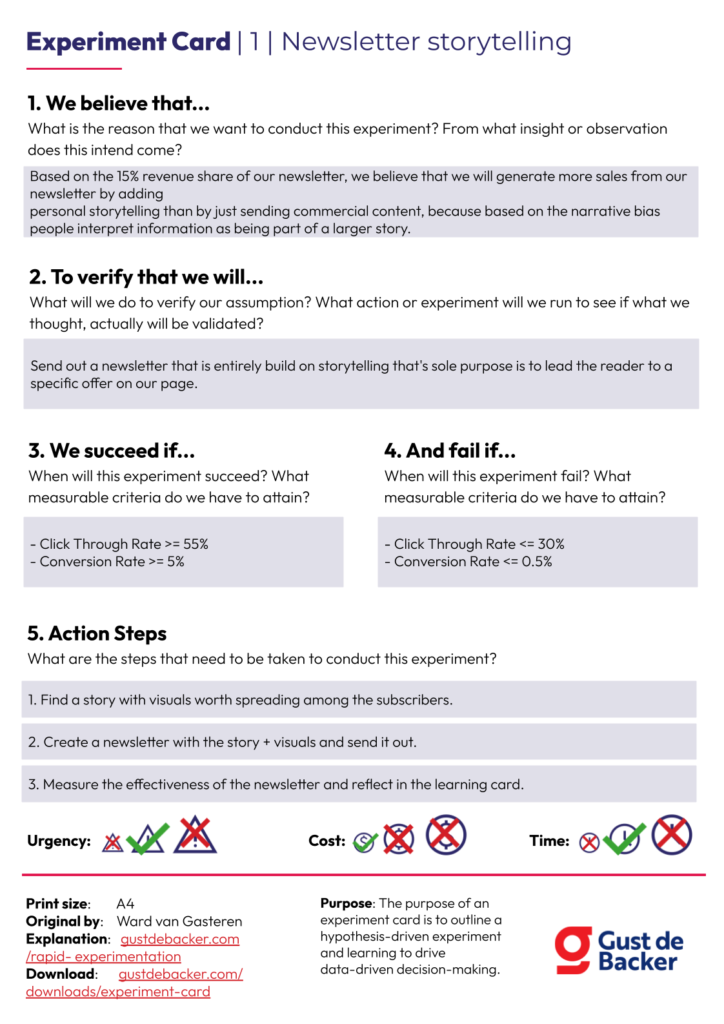What is an Experiment Card?
An Experiment Card is a strategic tool, designed to facilitate hypothesis testing in the realm of business development and product management. It helps structure ideas and assumptions that are integral to the evolution of your product or service, and serves as a roadmap to navigate the labyrinth of innovation.
This tool systematically captures essential elements including hypothesis, experiment details and minimum success criteria. Acting as a robust framework to execute experiments.
What is the outcome of using an Experiment Card?

By employing the Experiment Card, you will gain an in-depth understanding of the experiment process – from conception to completion. It allows you to define, execute, and assess your hypotheses in an orderly and disciplined fashion, fostering a culture of ‘learning by doing’.
By offering a concise summary of what the experiment should look like, you can make critical decisions about product features, market strategies, or operational improvements. Moreover, it allows teams to document initiatives, fostering knowledge transfer and continuous improvement in an organization.
Who’s the Experiment Card for?
The Experiment Card is for any individual or team striving to test assumptions in an organized, repeatable manner. It is primarily used by product managers, business strategists, marketers, and UX designers to validate their hypotheses about product features, user behavior, marketing strategies, and business models.
This tool is also valuable to entrepreneurs and startup founders, who need to constantly experiment and iterate their offerings to find a successful product-market fit. It’s a catalyst in an innovation-driven ecosystem, stimulating informed decision-making and adaptive learning.
How to use an Experiment Card?
Fill in the Experiment Card
- Define Your Hypothesis
Establish the assumption you aim to test. This hypothesis is an educated guess about the relationship between two variables, typically a feature or action, and a user’s behavior or a business outcome.
- Detail Your Experiment
Outline how you plan to test your hypothesis. This includes defining the method, identifying the target group, determining the duration, and setting up the necessary tools or resources.
- Set Minimum Success Criteria
Define the threshold or key metric which will determine if your experiment is successful.
- Start Experimenting
When the experiment is clear. Start experimenting, so that you can document your findings in the conclusion card.
What does it take to use an Experiment Card?
Using an Experiment Card requires a basic understanding of the scientific method, an open mind, and a commitment to data-driven decision making. It can be implemented quickly, often within a sprint cycle for agile teams. The primary resources needed include a team, strategic planners, and the relevant tools for running and analyzing the experiment.
Frequently Asked Questions
It’s advisable to review and update your Experiment Card after each experiment cycle. This ensures that the learnings from the experiment are recorded and that the next steps are planned effectively.
es, using multiple Experiment Cards concurrently is feasible and often necessary when you have several hypotheses to test. Just ensure each experiment is designed and managed properly to avoid mixing results.
Minimum Success Criteria should be a quantifiable metric that reflects the successful validation of your hypothesis. It may vary depending on the nature of the experiment and could be a certain conversion rate, a specific level of user engagement, or a definitive user feedback pattern.
No, a defined hypothesis is crucial for the Experiment Card. The hypothesis is the fundamental assumption you are trying to validate, and the whole experiment revolves around this. Without it, your experiment would lack direction and purpose.



